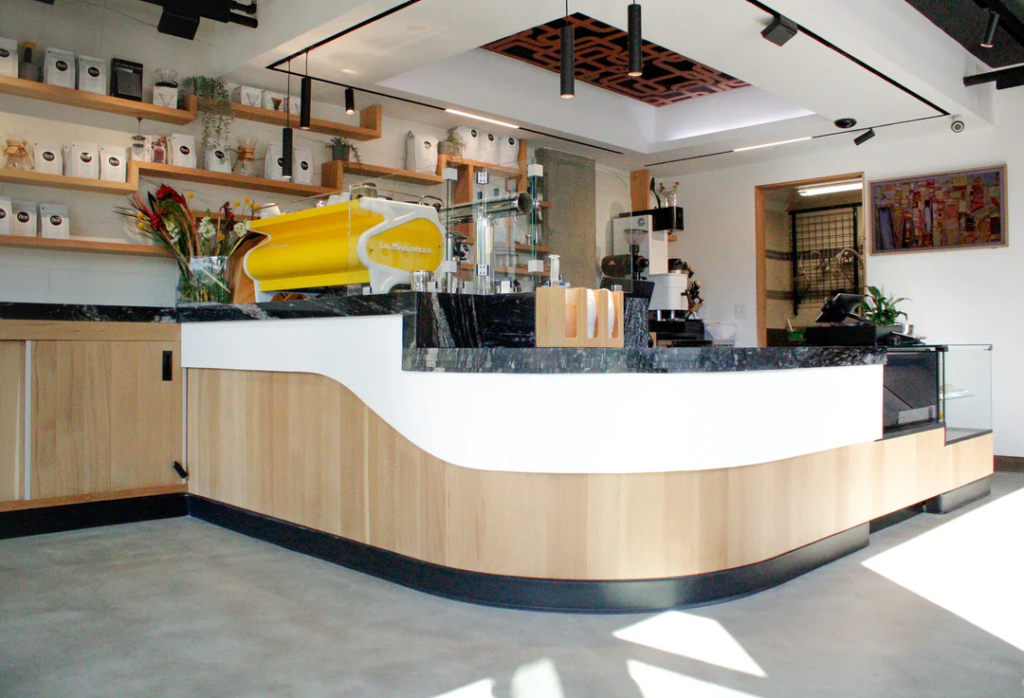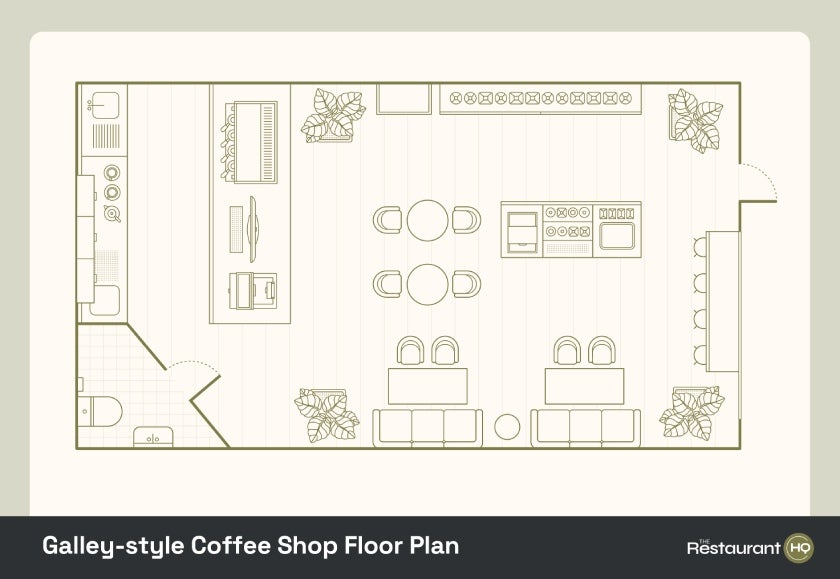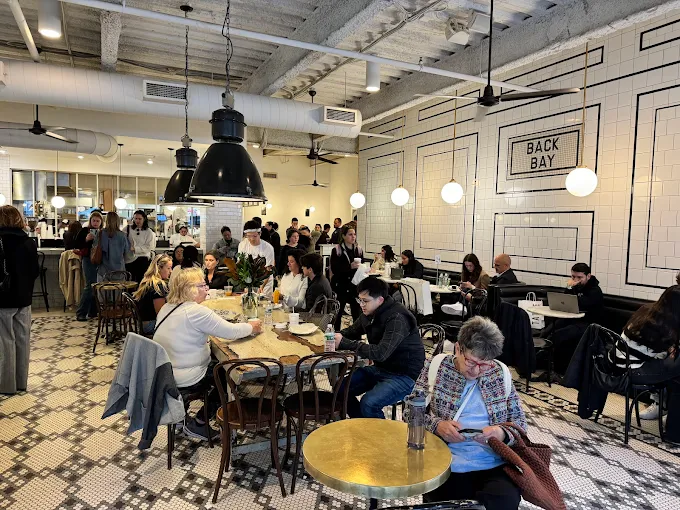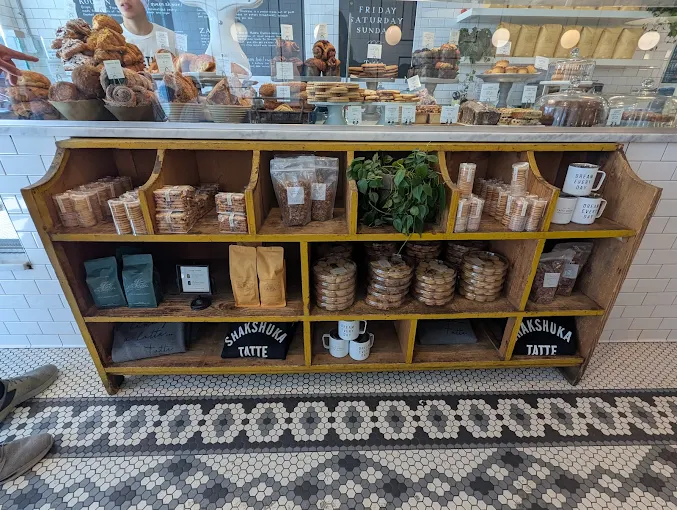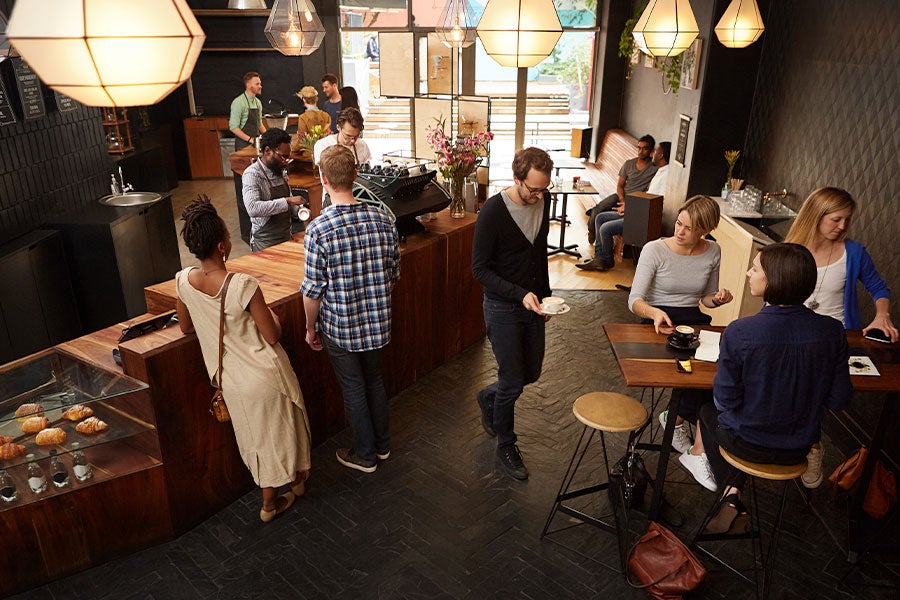Your coffee shop’s layout is as important as where you source your beans. A good coffee shop floor plan supports your shop’s electrical, plumbing, and sanitation needs and uses furnishings to invite customers in while subtly guiding them through the ordering process. It also ensures you have enough in-store diners present to cover the cost of your rent.
The best coffee shop floor plans are easy to navigate and have five key zones, including:
- A front-of-house to manage customer flow
- Ordering, pick-up, and other service areas
- Staff areas or back-of-house, plus restrooms
- Kitchen or prep areas, plus an espresso station
- Space for furniture, fixtures, and equipment (FF&E)
And each of these zones will need to adhere to the accessibility standards set by the Americans with Disabilities Act (ADA). To help inspire your choices, I’ve compiled four coffee shop layout plans, along with insights into the ideal size, location, and target customer for each layout.
Then, I’ll dig into the step-by-step design process to help you optimize daily operational efficiency, choose the best furniture, make use of vertical storage, and more.

Free coffee shop business plan from Toast
Your business plan outlines your entire vision and explains how your coffee shop will take shape and operate. Download the free template and learn how to write an executive summary, establish an operations plan, conduct market and financial analysis, and more.
Coffee counter layout plan for city centers, business districts & transportation hubs
Coffee counters are pit-stop coffee shops that rely on grab-and-go sales without seating. This coffee shop layout relies less on ambient lighting and other mood-setting amenities, because it’s not the kind of place customers stay a while.
Why it works: The small footprint allows this shop to meet customers where they are, in business cores or near rail lines — and proves you don’t need much space to start a coffee shop.
This coffee shop floor plan is built for speed to serve customers quickly on their commutes or work breaks. A quick-stop shop should utilize vertical space to sell retail items like mugs and coffee beans or bodega-style purchases like newspapers and chewing gum.
Ideal location size: 600-800 square feet
Target customer: Commuters and office workers taking breaks who need grab-and-go convenience. Consider adding pre-packaged cold items like salads, sandwiches, and snacks like chips and fresh fruit at the counter to encourage upsells.
Galley-style coffee shop floor plan for large suburban shops with parking lots
This midsize coffee shop layout has a long espresso bar running in the back of the shop, furthest from the front entrance, and intimate seating arrangements of various sizes spread throughout. It may also have a drive-thru where zoning permits.
The newest location for my favorite coffee shop followed this layout almost to a T, a big departure from the smaller spaces occupying other locations. The location’s previous owner had a more full-service brunch and lunch concept, with long buffet tables in the middle of the space.
Usually, that meant long lines of people crowded between too-big tables, trapping patrons in their chairs. The new design is easier to rearrange and also takes a less-is-more approach, making the space feel bigger and far less crowded.
Why it works: Most of the shop is given to flexible, movable seating. Customers can move the furniture easily to accommodate different-sized groups, and staff can move furniture to accommodate events like live music and book readings.
This layout also pushes the espresso counter to the back of the shop to allow staff a broad view of the service floor, so they can easily see areas that need cleaning or restocking.
Ideal location size: 800-1,000 square feet
Target customer: Customers who want to socialize, write, or work remotely. Customer Wi-Fi is typically a must for these shops. Consider mixing up your furniture selection to accommodate parties of many sizes and putting outlets near two-top tables for those who want to use your shop as a co-working space.
Pocket coffee shop layout plan for shopping centers & malls
With an espresso bar facing a wide open entrance, limited seating, and lots of retail display space on the walls, this circular configuration makes the most of tight spaces.
Why it works: Circular countertops and seating spaces remove sharp angles that can be difficult to move around. Staff and customers can maneuver easily around the space. The lower levels of the circular bar are ideal for showcasing impulse purchases.
Ideal location size: 900-1,300 square feet
Target Customer: Shoppers, travelers, and sporadic one-time customers are most common for pocket shops. Socializers are a secondary customer type, though, so you should have a few small, comfortable seating areas.
Large coffee shop layout plan for cities & suburbs
Large coffee house layouts have the means to provide ample lounge seating spread across various levels and rooms, allowing customers to use the space as a meeting place for casual dates or business meetings. Thanks to square footage, these coffee shops can typically feature multiple cold or dry storage units for fresh-baked goods or other hot, dine-in items.
Why it works: Large coffee shops have a community expectation, so they act as a backup living or meeting room for local residents and travelers. As a result, many large coffee shops create room dividers with shelves or furniture that display merchandise.
To allow room for lines to form, the espresso counter tends to run along the widest wall and be sited at the back of the shop. Where zoning allows, large shops set back from the road benefit from signage posted at a height that can be seen for several blocks or even a nearby highway.
Ideal location size: 3,500 to 4,000-plus square feet
Target customer: One-time visitors on shopping excursions or vacations are common in this type of shop. They are also common meeting places for customers to meet and socialize. These shops have lots of comfortable seating and a plan for staging live music.
How to design a coffee shop floor plan in 7 steps
Now that your creative juices are flowing and you’ve seen some top-shelf examples, let’s talk about how to physically create your coffee shop or cafe floor plan layout, from the idea stage to blueprints and equipment placement.
- Draw your basic floor plan
- Assess your operational needs
- Design your counter, ordering, and pick-up zones
- Place utilities and equipment
- Plan your flow of traffic
- Check for accessibility, licensing, and health code compliance
- Add furnishings and fixtures to accommodate three common customer types
Step 1: Draw your basic floor plan
This is your “I start my business on the back of a sushi napkin” moment. So it doesn’t have to be super formal. Yes, you can start visualizing your coffee shop floor plan in a sketch on a piece of graph paper or with an app like SmartDraw. But, really, anything will do.

As you sketch out your space, define clear sections with zones for ordering, picking up, and dining in. If you intend to have coolers for grab-and-go items or retail space, include that too. Include as many details as you can, like where you want your espresso machine, prep area, dishwasher, etc.
If you’re lucky enough to have the blueprints or plans from your space’s previous owner, use them as a template and identify where utilities, entrances, and exits are located.
Finding existing utilities like electrical and water lines will show you where you can logically place equipment like Wi-Fi routers, POS systems, charging stations, and outlets, and fit counters, refrigerators, sinks, and dishwashers. If your location is a raw space, there won’t be any lines run yet. So you’ll need to find a contractor to give you an estimate on running lines where you need them.
Ideally, you’ll have a separate entrance for supplies and customers so your customers don’t need to step around delivery dollies to get their morning coffee. The main customer entrance will also influence the location, size, and shape of your main service counter. You should note all the existing entrances and exits on your floor plan drawing.
Step 2: Assess your operational needs
The next step in creating a coffee shop floor plan is detailing what you plan to sell, which of those items you plan to prepare in-house, and how many staff members and customers will be in your space simultaneously.
Start by asking yourself these questions:
- What will I serve? Be specific. There are many ways to prepare coffee: fresh-brewed, in specialty espresso drinks, as pour-overs, French-pressed, etc.
Not everyone drinks coffee, but many want the coffeehouse experience, so you might consider brewed teas, iced beverages, or even beer and cold brew on tap. And there are just as many ways to customize drinks with dairy-free milk alternatives, flavored syrups, and housemade sauces.
- Will I prepare each item that I sell? Concepts that feature fuller kitchens might opt for preparing grab-and-go items each day or making hot food to order.
Others partner with local suppliers to bring in baked goods and bottled beverages ready-made. The size of your space and the scope of your concept will help you decide all of these things. Answering this question will also prompt you to consider where and how you’re going to receive or store these items.
- Will I sell retail goods or merchandise? The beautiful part of merchandise is that it has a long shelf life. Mugs, tumblers, totes, and T-shirts are all great coffee shop products — and hallmarks of effective coffee shop marketing. Just don’t pressure yourself to do too much at once.
The coffee shop closest to me has been open for a year and only just started stocking merch items like shirts and hats. In that time, they let their customers decide what other items to sell, like tumblers and other items featuring their signature drink, the Salty Gal.
This space also features a walk-up window where patrons get coffee with their pets, which sparked the idea to sell handmade leashes and printed bandanas.
- How many baristas will work at the same time? And how many cashiers, for that matter? You’ll need space for all the staff to work around one another, at least three square feet per employee at a minimum.
- How many customers will visit my shop at peak times? This will determine how much space you need to allow for lines. If you’re not yet open, visit nearby coffee shops to get an idea of how many customers you can expect.
- Do I want my customers to dine in or grab and go? A kiosk or bodega-style concept may not need a lot of tables and chairs. But you want to sell beer on tap, for example, space to sit and enjoy is a must.
- What balance of dine-in to grab-and-go do I want? This is a crucial question for any coffee shop owner. If you offer both dine-in and take-out, what do you want your space to highlight more? Do you need more people in your dining room, often with higher check averages, or do you expect to be more successful with a higher amount of take-out orders?
Once you’ve answered these questions, note an estimated volume of each item you’ll expect to use in a week to support your customer volume and sales projections. You’ll need to add enough storage space to your coffee shop floor plan for supplies and backstock.
If you don’t have a lot of storage space (many coffee shops don’t), negotiate with your suppliers to get multiple deliveries throughout the week. You’ll need more administrative bandwidth to check in orders and manage invoices, but you won’t need as much on-site storage space.
Step 3: Design your counter, ordering, and pick-up zones
Now, it is time to take the information from the previous steps to identify the best place on your floor plan to place your counter.
The service counter is the focal point of your coffee shop. Don’t get boxed into a single straight line. Depending on your location’s size, the shape of the counter might be diagonal or even circular. Use the floor plan examples at the top of this article as inspiration.
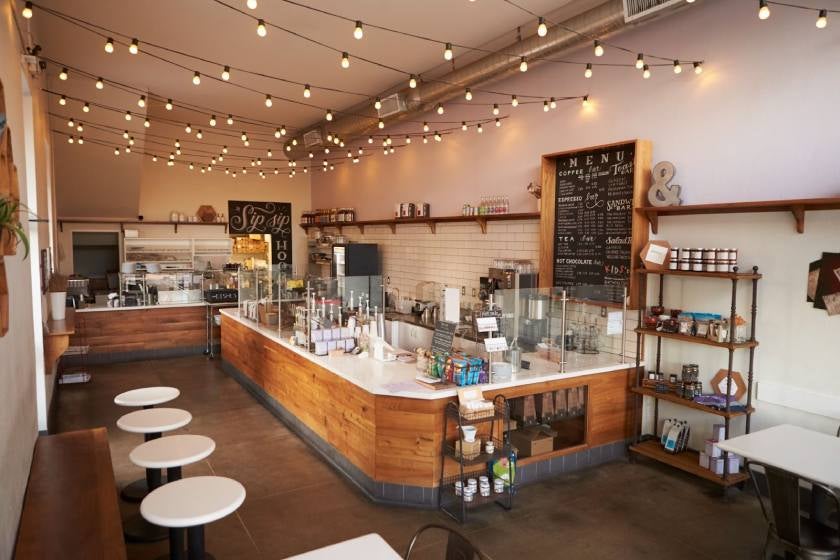
When placing your counter, also consider the location of your entrance, utilities, and equipment. It’s ideal for your counter to face your customer entrance. This makes it easy to see and greet customers. Meanwhile, your service counter will house electrical equipment like your POS, water lines, and drain lines to support your espresso machine, coffee brewers, and sinks.
You may also need built-in, reach-in refrigerators and chilled display cases. So you need to be sure that you place your counter in a spot where you can bring all of these utilities together. Most importantly, the counter itself needs to be about two feet wide to fit an espresso machine.
In addition to the counter, you’ll need a back bar workspace for your staff on one side and a gathering space for customers on the other. You’ll need to allow for at least 14 feet of width on your floor plan for these areas.
Sketch out a preliminary counter layout on your app. If you’re hand-drawing, sketch your counter options on a separate piece of graph paper. You can cut out the sample counter and try placing it in different configurations on your paper plan.raph paper. You can cut out the sample counter and try placing it in different configurations on your paper plan.
Step 4: Place utilities and equipment
Coffee shop equipment comes in multiple sizes, so you should choose your equipment before finalizing your coffee shop floor plan. You may discover that you need to source smaller equipment or build larger counters to accommodate the equipment you need.
Local building codes and health department regulations will have an impact on the type of equipment you use and its placement. Hand-washing sinks and dishwashers require floor drains, while refrigerators and ovens require adequate ventilation space.
It’s a good idea to get the advice of a contractor familiar with installing restaurant equipment to let you know where you can place large equipment like walk-in refrigerators and ovens. Otherwise, consider local health and building codes when choosing and placing equipment.
- Local health code standards will require the placement of sinks for hand-washing and dish-washing. You will also need enough refrigerators to keep perishable products like milk below 41 degrees Fahrenheit.
- Local building codes may require consultation with an architect or building contractor to ensure that water lines, electrical lines, ventilation, and sanitation adhere to local regulations.
- Communication tools and Wi-Fi will be essential to your operation. Many coffee shops use a cloud-based or top iPad point-of-sale (POS) system. If you use one, you want to be sure that the Wi-Fi router is not blocked by walls.
Some technicians will caution against placing routers too close to refrigerators, as these barriers can create communication issues and system malfunctions.
Get the measurements for any equipment you are thinking about. Add the equipment options to your app-based or paper floor plan (in the same way that you did for your counter options). Try different configurations to find the equipment that fits best in your shop.
Step 5: Plan your flow of traffic
Before your floor plan gets too crowded, you need to think about foot traffic. There needs to be enough open space in your floor plan for people to stand.
It’s best when your coffee shop’s floor plan makes it clear where customers should form lines. The placement of fixtures and furniture can provide the space for line formation — an aisle at least 36 inches wide is best — while signage can provide visual cues. If your shop is busy enough, plan for a custom queue that folds around shelving or stanchions.
Step 6: Check for accessibility, licensing, and health code compliance
Ensure that your shop is accessible to people with mobility issues and other disabilities to create an inclusive environment and expand your customer base. All places of business open to the public have certain obligations that fall under ADA compliance that will impact the width of aisles, doorways, counter heights, and restroom design.
You’ll want to keep these ADA-recommended measurements in mind as you lay out your aisles and set aside space for bathrooms and line formation.
- Doorways must be at least 32 inches wide, and most hallways and passages should be at least 36 inches wide.
- Wheelchairs need at least 60 inches of space to turn around completely, though a properly configured T-junction also allows room for turning. These dimensions are especially important in designing an accessible restroom.
- To be accessible to customers in wheelchairs, your condiment stations should be no more than 34 inches tall. If your self-service areas are higher than this, be sure to add an alternative self-service station that is 34 inches or lower.
Adhering to the ADA is good for business. The Administration on Aging projects that there will be more than 69 million Americans age 65 and older by 2030, making up approximately 20% of the total US population. Add this to the already 50 million Americans with disabilities, and you’re looking at a customer base that outnumbers any single cultural, racial, or ethnic group in the country.
Step 7: Add furnishings and fixtures to accommodate three common customer types
Your coffee shop floor plan is practically complete. The final flourish is adding your fixtures (like ambient lighting and a sound system) and furnishings (like chairs, tables, stools, and retail displays).
The fixtures and furnishings that are best for your shop will vary based on your target customer. You can break down most of a coffee shop’s regular customers based on the ways they use a coffee shop space.
The main coffee shop customer types are sightseers, socializers, and break-takers. These three have different expectations of an ideal coffee shop experience, and their preferences will influence the type and placement of your coffee shop’s fixtures and furnishings.
Take note of the dimensions of your preferred furnishings and fixtures and add them to your floor plan. Lay them out before you order them to ensure that your preferred items will fit in your space and leave enough room for your staff and customers to easily move throughout your shop.
With your furniture and fixtures added to your sketch, your coffee shop floor plan is complete. Depending on how you plan to use it — as part of a business plan or to entice investors — you may want to turn over your work to a professional designer to polish it. You can find one by asking other businesses who they use or using freelancing sites like Fiverr or Upwork.
Drugstore Coffee’s floor plan makes big use of a small space
This Nashville coffee shop is located in the lobby of the Noelle Hotel in downtown Nashville. The smart floor plan makes clever use of a small space, with seating that appeals to groups and single patrons.
Tucked just beside the hotel’s main entrance, inside the main lobby, the location supports foot traffic from hotel guests and break-takers from nearby offices.
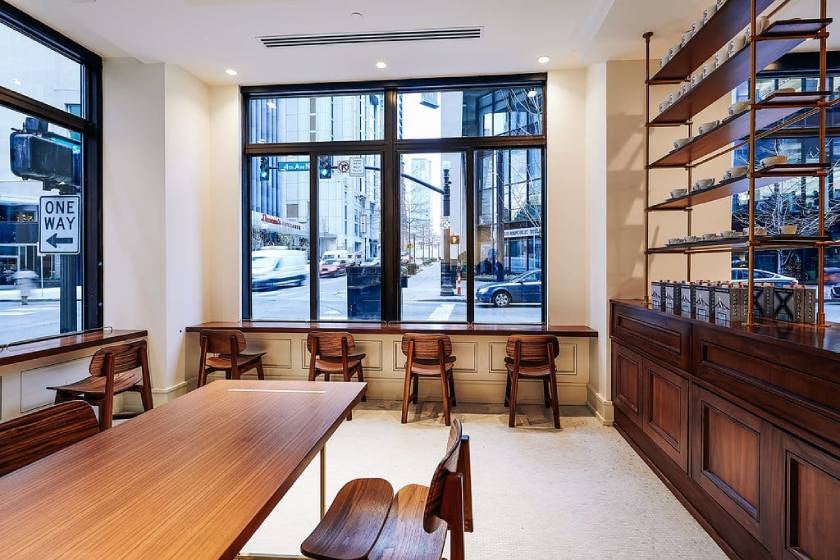
There are a lot of great details in the Drugstore Coffee floor plan, from the variety of seating options to the long service counter and excellent use of natural light. This coffee shop also has the advantage of sharing storage spaces with the hotel, so they don’t have to worry about maintaining space for hundreds of to-go cups and retail backstock.
Last bite
Planning your coffee shop floor plan is a crucial step to opening a coffee shop. The best coffee shop floor plans are based on the shop’s location, size, and target customer, but also consider the general vibe of your concept.
Most independent coffee shop owners plan the placement of fixtures, furnishings, and product displays alone or with the support of their suppliers. You will, however, need to ensure that water lines, electrical lines, and ventilation and sanitation plans adhere to building and health codes.


